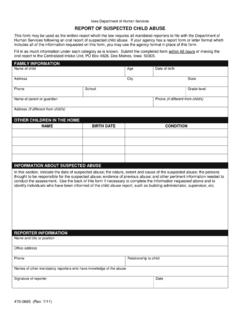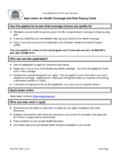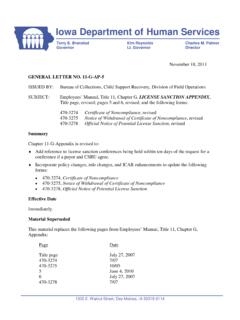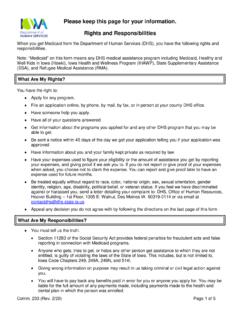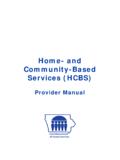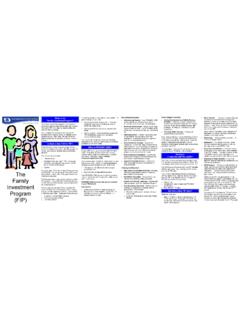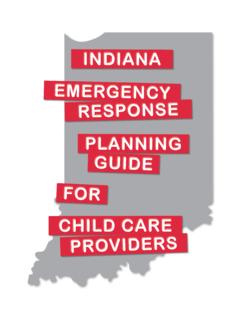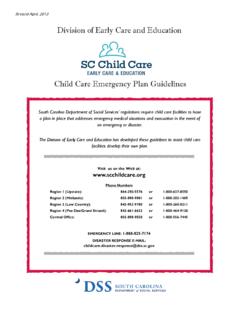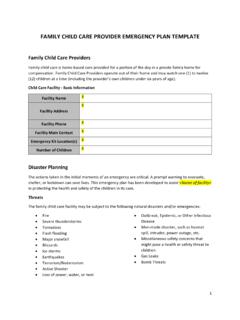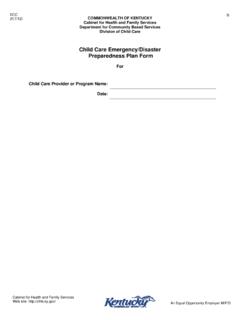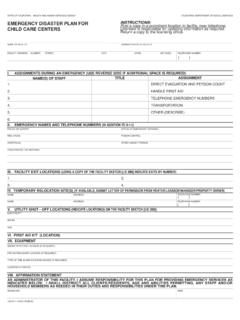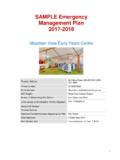Transcription of Emergency Preparedness Plan ning Document For …
1 1 Emergency Preparedness planning Document FOR CENTER PROVIDERS Emergency Preparedness planning Document For Iowa child care Providers: Preschools & Centers 2 Emergency Preparedness planning Document FOR CENTER PROVIDERS Why Is An Emergency plan Important? The responsibility of caring for children on a daily basis keeps child care providers very busy, making it difficult to prioritize planning for what could happen. However, those child care programs that take the time to thoughtfully make a plan and implement steps to be prepared are better able to protect lives and return to normal operation in a shorter period of time when an Emergency does happen. Young children, families and communities depend on child care to protect their children and to be available so parents have a safe place for their children while they restore the community. Don t We Already Do This As Part of Licensing Regulations? An Emergency Preparedness plan is not an entirely new concept for child care businesses.
2 The Department of Human Services regulations require the following written policies: (15) Emergency plans. a. The center shall have written Emergency plans for responding to fire, tornado, flood (if area is susceptible to flood), intruders within the center, intoxicated parents and lost or abducted children. In addition, the center shall have guidelines for responding or evacuating in case of blizzards, power failures, bomb threats, chemical spills, earthquakes, or other disasters that could create structural damage to the center or pose health hazards. If the center is located within a ten-mile radius of a nuclear power plant or research facility, the center shall also have plans for nuclear evacuations. Emergency plans shall include written procedures including plans for transporting children and notifying parents, Emergency telephone numbers, diagrams, and specific considerations for immobile children. b. Emergency instructions, telephone numbers, and diagrams for fire, tornado, and flood (if area is susceptible to floods) shall be visibly posted by all program and outdoor exits.
3 Emergency plan procedures shall be practiced and documented at least once a month for fire and for tornado. Records on the practice of fire and tornado drills shall be maintained for the current and previous year. c. The center shall develop procedures for annual staff training on these Emergency plans and shall include information on responding to fire, tornadoes, intruders, intoxicated parents and lost or abducted children in the orientation provided to new employees. d. The center shall conduct a daily check to ensure that all exits are unobstructed. This plan is intended to build on the basic DHS requirements, providing a comprehensive, site specific plan for 1) Sheltering in place, 2) Evacuating, 3 Emergency Preparedness planning Document FOR CENTER PROVIDERS 3) Relocating, 4) Communicating, 5) Providing for those with special needs and 6) Reunifying families In addition to be complete, this plan requires a minimum of 24 hours of Emergency supplies for each child and staff member typically present in the facility.
4 Agreements or contracts will be needed for transportation services, if the facility does not have vehicles, and for securing shelter sites to assure that the plan decided on can actually be implemented. This Emergency plan can not likely be written in one sitting. It should not be written by one person, but by a team consisting of staff, board members (where applicable), corporate team members (where applicable), and parents. In addition, having community members such as: Local Emergency Management, a member of EMS, DHS Licensing Consultant, a child care Nurse Consultant or CCR&R Consultant review your plan and provide guidance would be beneficial. These agencies or staff are not approving your plan but can provide you with assistance, resources, and ideas for you to consider. You should also consider seeking advice from your legal counsel on areas dealing with parental rights, laws, liability, contracts, legal interpretations, etc. Center directors may feel additional training is needed prior to the center writing this comprehensive plan .
5 Training is available specifically for Iowa child care providers on Emergency Preparedness through child care Resource & Referral Agencies. Please contact your local CCR&R office or CCNC for training and/or consultation. How is planning For the Unique Needs of Children Different From the General Guidance Available? And Our Facility Cares For Children With Special Needs Is There Additional planning We Should Do? Facilities are more and more likely to be caring for children with special needs and/or employing staff with special needs. Some of these special needs may come to mind quickly such as chronic health conditions like a seizure disorder, diabetes, or g-tube. Other special needs may be readily recognized as well, such as a developmental delay, individuals with mobility or visual impairments. In addition though, infants and young children have special needs related to Emergency situations including being completely dependent on competent adults to remove them from dangerous situations and to provide for their needs.
6 If your plan utilizes an egress window as a primary or secondary exit are all staff and children able to exit out the egress window? Do you have staff members whose physical size, mobility, strength, or health condition causes you to question their ability to assist young children and then climb out the egress window? Can they adequately and quickly assist the children to assure safety? Can the staff member climb out of the egress window and then continue the evacuation plan with the children? Are they able to lift and carry the child who typically uses a wheelchair? Are staff members physically capable 4 Emergency Preparedness planning Document FOR CENTER PROVIDERS of performing their duties during an Emergency , but mentally or emotionally unable? Have you practiced unannounced drills, observing staff in a more authentic situation? Does a staff member freeze, and become unable to safely evacuate the children or panic and abandon the children? If a staff member is not able to perform this duty, what is your plan for ensuring the health and safety of the children and staff?
7 What is your plan in a lock down situation to keep infants and young children quiet, so as to not alert the intruder of their location? Without a plan , a staff member could panic and unintentionally smother an infant in attempt to keep her quiet. Supplies are an additional area to plan for in being prepared for children and staff with special needs. Critical medication, medical equipment (glucose monitor, nebulizer, tubing), medical supplies (test strips, adaptive equipment, communication device, adapted utensils), required food (allergen free, enteral nutrition for feeding tubes) and supplies needed for infants and toddlers such as formula, bottles, diapers, safety equipment, comfort items, etc. are examples of supplies you will need to consider for your facility. Young children will have additional developmental and social-emotional special needs due to their age and the way they process what is happening. planning and practicing with children and staff evacuating and relocating will decrease anxiety.
8 Put together a lesson plan of activities and have the minimal supplies need for those activities, so that staff can quickly transition the children into songs, stories, finger-plays and other activities that will distract and keep the children busy and feeling secure. planning ahead and providing lots of ideas, doesn t leave staff repeating 3 songs from memory, fumbling to think of ideas with increasing anxiety. Why Do We Need To Encourage Staff to Have A Family plan ? Developing a comprehensive plan is an important step for a child care business, and the most critical resource in the plan is the child care providers. Encouraging staff to have an Emergency Preparedness plan for their family will help staff feel more confident that their loved ones are safe and prepared for as they provide care for children in the child care facility during an Emergency . It is in everyone s best interest to be ready, and a child care facility can use this preparation time to share guidance, ideas and encourage family and staff Preparedness , too.
9 5 Emergency Preparedness planning Document FOR CENTER PROVIDERS I. child care Program Information Name of program Street address City State Zip code Telephone number Alternate phone number E-mail address Emergency out of area telephone number Director s Emergency Contact Info Center Director Director s Emergency contact information (Specific number or categories not required, at least 3 people recommended) Members of Our Emergency planning Team Center Director Staff member Parent Board Member Board Member Other ( Emergency Management Office, DHS licensing, CCNC, CCR&R, EMS) Other (legal counsel) Contact Information for Others With Whom This plan is Coordinated (Neighbors) (Businesses; schools) Local Emergency Management EMS (fire, police and rescue) CCR&R Insurance provider Others 6 Emergency Preparedness planning Document FOR CENTER PROVIDERS This introductory paragraph can be deleted from your plan it has been provided to assist those writing the plan .
10 Shelter-in-Place is the term used when there is an Emergency , typically weather related, that makes it unsafe to leave the facility. Examples: Winter storm, severe thunderstorm/wind storm, tornado, etc. The shelter-in-place manager is the person in charge of what happens in the sheltering area. You will define the responsibilities for that person, which can include overseeing that supplies are stocked and the area is prepared in advance of needing the shelter, unlocking the area, supervising children and staff in the shelter area and leading the chain of command in decision making, etc. The alternate shelter-in-place manager ensures that if the primary person is not at the facility there is another person who understands the role and can function equally in that role. A lock down is typically a shelter-in-place to protect children and staff from a violent situation outside or in a portion of the facility. Examples: Domestic violence between a staff member and a partner, non-custodial parent attempts to pick up child and situation is escalating, escaped prisoner or mentally ill patient in neighborhood, armed student or staff member, a riot outside, etc.

